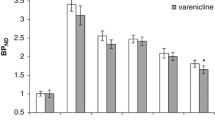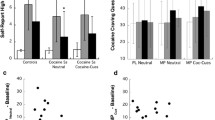Abstract
Rationale
Recent biological conceptualizations of craving and addiction have implicated mesolimbic dopamine activity as a central feature of the process of addiction. Imaging, and pharmacological studies have supported a role for dopaminergic structures in cue-elicited craving for tobacco.
Objective
If mesolimbic dopamine activity is associated with cue-elicited craving for tobacco, a dopamine antagonist should attenuate cue-elicited craving for tobacco. Thus, the aim of the present study was to determine whether an atypical antipsychotic (olanzapine, 5 mg) decreased cue-elicited craving for tobacco.
Method
Participants were randomly assigned to 5 days of pretreatment with olanzapine (5 mg; n=31) or were randomly assigned to 5 days of a matching placebo (n=28). Approximately 8 h after the last dose, participants were exposed to a control cue (pencil) followed by exposure to smoking cues. Participants subsequently smoked either nicotine cigarettes or de-nicotinized cigarettes.
Results
Olanzapine attenuated cue-elicited craving for tobacco but did not moderate the subjective effects of smoking.
Discussion
This study represents one of the first investigations of the effect of atypical antipsychotics on cue-elicited craving for tobacco. The results suggest that medications with similar profiles may reduce cue-elicited craving, which in turn, may partially explain recent observations that atypical antipsychotics may reduce substance use.


Similar content being viewed by others
References
Berridge KC, Robinson TE (1998) What is the role of dopamine in reward: hedonic impact, reward learning, or incentive salience? Brain Res Brain Res Rev 28:309–369
Brauer LH, Cramblett MJ, Paxton DA, Rose JE (2001) Haloperidol reduces smoking of both nicotine-containing and denicotinized cigarettes. Psychopharmacology 159:31–37
Butschky M, Bailey D, Henningfield JE, Pickworth WB (1995) Smoking without nicotine delivery decreases withdrawal in 12-h abstinent smokers. Pharmacol Biochem Behav 50:91–96
Carter BL, Tiffany ST (1999) Meta-analysis of cue-reactivity in addiction research [see comments]. Addiction 94:327–340
Caskey NH, Jarvik ME, Wirshing WC (1999) The effects of dopaminergic D2 stimulation and blockade on smoking behavior. Exp Clin Psychopharmacol 7:72–78
Caskey NH, Jarvik ME, Wirshing WC, Madsen DC, Iwamoto-Schaap PN, Eisenberger NI, Huerta L, Terrace SM, Olmstead RE (2002) Modulating tobacco smoking rates by dopaminergic stimulation and blockade. Nicotine Tobacco Res 4:259–266
Dallery J, Houtsmuller EJ, Pickworth WB, Stitzer ML (2003) Effects of cigarette nicotine content and smoking pace on subsequent craving and smoking. Psychopharmacology 165:172–180
Dawe S, Gerada C, Russell MA, Gray JA (1995) Nicotine intake in smokers increases following a single dose of haloperidol. Psychopharmacology 117:110–115
Del Boca FK, Kranzler HR, Brown J, Korner PF (1996) Assessment of medication compliance in alcoholics through UV light detection of a riboflavin tracer. Alcohol Clin Exp Res 20:1412–1417
Drake RE, Xie H, McHugo GJ, Green AI (2000) The effects of clozapine on alcohol and drug use disorders among patients with schizophrenia. Schizophr Bull 26:441–449
Due DL, Huettel SA, Hall WG, Rubin DC (2002) Activation in mesolimbic and visuospatial neural circuits elicited by smoking cues: evidence from functional magnetic resonance imaging. Am J Psychiatry 159:954–960
Durcan MJ, Deener G, White J, Johnston JA, Gonzales D, Niaura R, Rigotti N, Sachs DP (2002) The effect of bupropion sustained-release on cigarette craving after smoking cessation. Clin Ther 24:540–551
George TP, Ziedonis DM, Feingold A, Pepper WT, Satterburg CA, Winkel J, Rounsaville BJ, Kosten TR (2000) Nicotine transdermal patch and atypical antipsychotic medications for smoking cessation in schizophrenia. Am J Psychiatry 157:1835–1842
Goldstein MG (1999) Missed opportunities to assist hospitalized smokers. Am J Prev Med 17:317–318
Green AI, Zimmet SV, Strous RD, Schildkraut JJ (1999) Clozapine for comorbid substance use disorder and schizophrenia: do patients with schizophrenia have a reward-deficiency syndrome that can be ameliorated by clozapine? Harv Rev Psychiatry 6:287–296
Hutchison KE, Niaura R, Swift R (1999) Smoking cues decrease prepulse inhibition of the startle response and increase subjective craving in humans. Exp Clin Psychopharmacol 7:250–256
Hutchison KE, Niaura R, Swift RM (2000) The effects of smoking high nicotine cigarettes on prepulse inhibition, startle latency, and subjective responses. Psychopharmacology 150:244–252
Hutchison KE, Swift R, Rohsenow DJ, Monti PM, Davidson D, Almeida A (2001) Olanzapine reduces urge to drink after drinking cues and a priming dose of alcohol. Psychopharmacology 155:27–34
Hutchison KE, LaChance H, Niaura R, Bryan AD, Smolen A (2002) The DRD4 VNTR poylmorphism influences reactivity to smoking cues. J Abnorm Psychol 111:134–143
Hutchison KE, Wooden A, Swift RM, Smolen A, McGeary J, Adler L, Paris L (2003) Olanzapine reduces craving for alcohol: a DRD4 VNTR polymorphism by pharmacotherapy interaction. Neuropsychopharmacology 28:1882–1888
Lee ML, Dickson RA, Campbell M, Oliphant J, Gretton H, Dalby JT (1998) Clozapine and substance abuse in patients with schizophrenia. Can J Psychiatry 43:855–856
Martin CS, Earleywine M, Musty RE, Perrine MW, Swift RM (1993) Development and validation of the biphasic alcohol effects scale. Alcohol Clin Exp Res 17:140–146
McEvoy JP, Freudenreich O, Levin ED, Rose JE (1995a) Haloperidol increases smoking in patients with schizophrenia. Psychopharmacology 119:124–126
McEvoy J, Freudenreich O, McGee M, VanderZwaag C, Levin E, Rose J (1995b) Clozapine decreases smoking in patients with chronic schizophrenia. Biol Psychiatry 37:550–552
Niaura R, Abrams DB (2002) Smoking cessation: progress, priorities, and prospectus. J Consult Clin Psychol 70:494–509
Niaura RS, Rohsenow DJ, Binkoff JA, Monti PM, Pedraza M, Abrams DB (1988) Relevance of cue reactivity to understanding alcohol and smoking relapse. J Abnorm Psychol 97:133–152
Niaura R, Abrams DB, Pedraza M, Monti PM, Rohsenow DJ (1992) Smokers’ reactions to interpersonal interaction and presentation of smoking cues. Addict Behav 17:557–566
Niaura R, Shadel WG, Abrams DB, Monti PM, Rohsenow DJ, Sirota A (1998) Individual differences in cue reactivity among smokers trying to quit: effects of gender and cue type. Addict Behav 23:209–224
Pickworth WB, Fant RV, Nelson RA, Rohrer MS, Henningfield JE (1999) Pharmacodynamic effects of new de-nicotinized cigarettes. Nicotine Tobacco Res 1:357–364
Robinson TE, Berridge KC (1993) The neural basis of drug craving: an incentive-sensitization theory of addiction. Brain Res Brain Res Rev 18:247–291
Robinson M, Houtsmuller E, Moolchan ET, Pickworth WB (2000) Placebo cigarettes in smoking research. Exp Clin Psychopharmacol 8:326–332
Sayette MA, Hufford MR (1994) Effects of cue exposure and deprivation on cognitive resources in smokers. J Abnorm Psychol 103:812–818
Sayette MA, Shiffman S, Tiffany ST, Niaura RS, Martin CS, Shadel WG (2000) The measurement of drug craving. Addiction 95:S189–S210
Sayette MA, Martin CS, Wertz JM, Shiffman S, Perrott MA (2001) A multi-dimensional analysis of cue-elicited craving in heavy smokers and tobacco chippers. Addiction 96:1419–1432
Shiffman S, Paty JA, Gnys M, Kassel JA, Hickcox M (1996) First lapses to smoking: within-subjects analysis of real-time reports. J Consult Clin Psychol 64:366–379
Shiffman S, Elash CA, Paton SM, Gwaltney CJ, Paty JA, Clark DB, Liu KS, Di Marino ME (2000a) Comparative efficacy of 24-hour and 16-hour transdermal nicotine patches for relief of morning craving. Addiction 95:1185–1195
Shiffman S, Johnston JA, Khayrallah M, Elash CA, Gwaltney CJ, Paty JA, Gnys M, Evoniuk G, DeVeaugh-Geiss J (2000b) The effect of bupropion on nicotine craving and withdrawal. Psychopharmacology 148:33–40
Shiffman S, Shadel WG, Niaura R, Moise KA, Jorenby DE, Ryan CF, Ferguson CL (2003) Efficacy of acute administration of nicotine gum in relief of cue-provoked cigarette craving. Psychopharmacology 166:343–350
Swift RM, Whelihan W, Kuznetsov O, Buongiorno G, Hsuing H (1994) Naltrexone-induced alterations in human ethanol intoxication. Am J Psychiatry 151:1463–1467
Tiffany ST (1990) A cognitive model of drug urges and drug-use behavior: role of automatic and nonautomatic processes. Psychol Rev 97:147–168
Tiffany ST (1995) The role of cognitive factors in reactivity to drug cues. In: Drummond STTDC, Glautier S, Remington B (eds) Addictive behaviour: cue exposure theory and practice, vol 7. Wiley, New York, pp 137–165
Tiffany ST, Carter BL, Singleton EG (2000) Challenges in the manipulation, assessment and interpretation of craving relevant variables. Addiction 95:S177–S187
Watson D, Clark LA, Tellegen A (1988) Development and validation of brief measures of positive and negative affect: the PANAS scales. J Person Soc Psychol 54:1063–1070
Wise RA (1988) The neurobiology of craving: implications for the understanding and treatment of addiction. J Abnorm Psychol 97:118–132
Zimmet SV, Strous RD, Burgess ES, Kohnstamm S, Green AI (2000) Effects of clozapine on substance use in patients with schizophrenia and schizoaffective disorder: a retrospective survey. J Clin Psychopharmacol 20:94–98
Acknowledgments
This research was supported by grants from the Eli Lilly & Company and the National Cancer Institute (1R21CA81637) as well as grant 2 M01-RR00051 from the General Clinical Research Center Program of the National Center for Research Resources, National Institutes of Health.
Author information
Authors and Affiliations
Corresponding author
Rights and permissions
About this article
Cite this article
Hutchison, K.E., Rutter, MC., Niaura, R. et al. Olanzapine attenuates cue-elicited craving for tobacco. Psychopharmacology 175, 407–413 (2004). https://doi.org/10.1007/s00213-004-1837-3
Received:
Accepted:
Published:
Issue Date:
DOI: https://doi.org/10.1007/s00213-004-1837-3




